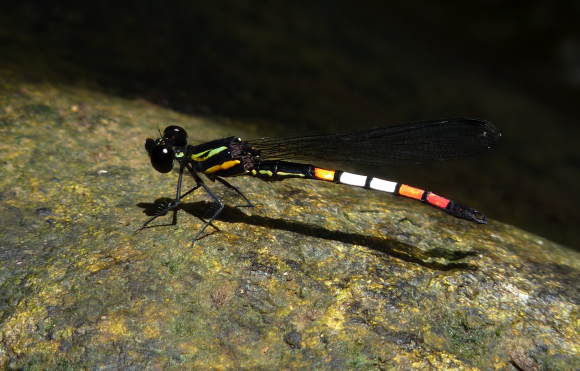Genus Africocypha Pinhey, 1961
eccentric jewels
Type species: Chlorocypha greyi Pinhey, 1961 [= lacuselephantum Karsch, 1899]
Introduction
This localized Lower Guinean genus demonstrates some of the most unusual colour variation in Odonata. The three species are very different and may thus be difficult to separate from the abundant Chlorocypha, but possess the unusual combination of a largely blue face, all black tibiae, broad abdomen with largely black uppersides of abdominal segments 9-10, and paraprocts that are half as long as the cerci. A. centripunctata and A. lacuselephantum are among the largest African jewels (hindwing 24-29 mm), the former confined to highlands on the southern Nigeria-Cameroon border, the latter to those in south-western Cameroon, Bioko and southern Gabon. The A. lacuselephantum male’s middle five abdominal segments are bluish white, first turning orange and then red, starting at abdominal segment 8, then 4, 7, 5 and finally 6, thus showing between one and three tones depending on age. Females are wholly orange at emergence, but blacken largely and develop dorsal abdominal spots colouring in a sequence like that of males. Mature males of the small (hindwing 21-23 mm) A. varicolor from south-eastern Gabon invariably have abdominal segments 2-5 red, but 6-9 can be either red, blue or yellow (and rarely orange). Whether such males differ in their reproductive behaviour remains to be proven. Females have rarely been seen, but can be entirely orange or blue. No colour variation is known in A. centripunctata. [Adapted from Dijkstra & Clausnitzer 2014]
Diagnosis
While morphologically very disparate, males of the three species recognised have in common the combination of (a) great size, Hw 21-29; (b) the largely blue labrum, anteclypeus and genae; (c) the all black tibiae; (d) the broad abdomen with the dorsa of S9-10 largely black; and (e) the paraprocts that are at least half as long as the cerci. [Adapted from Dijkstra, Kipping & Mézière 2015]

Africocypha lacuselephantum (Karsch, 1899). Male © Nicolas Meziere
Map citation: Clausnitzer, V., K.-D.B. Dijkstra, R. Koch, J.-P. Boudot, W.R.T. Darwall, J. Kipping, B. Samraoui, M.J. Samways, J.P. Simaika & F. Suhling, 2012. Focus on African Freshwaters: hotspots of dragonfly diversity and conservation concern. Frontiers in Ecology and the Environment 10: 129-134.
Reference
- Dijkstra, K.-D.B. (2007). The name-bearing types of Odonata held in the Natural History Museum of Zimbabwe, with systematic notes on Afrotropical taxa. Part 2: Zygoptera and species descriptions. International Journal of Odonatology, 10, 137-170. [PDF file]
Citation: Dijkstra, K.-D.B (editor). African Dragonflies and Damselflies Online. http://addo.adu.org.za/ [2024-10-30].

